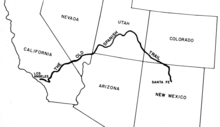Old Spanish Trail
The Old Spanish Trail ( Spanish : Viejo Camino Español ) is a historic trade route in the western part of today's United States .
It connects Santa Fé in northern New Mexico via Utah and Nevada with Los Angeles in California . The route is about 2000 kilometers long and leads through mountains, deserts and deep canyons . After the route was first explored by European settlers in 1776, its use increased significantly from the mid-1850s at the latest.
The importance of the path lies in the connection between Nuevo Mexico , the northernmost and most remote part of the Spanish viceroyalty of New Spain , with the coast in California . This connected two regions that were characterized by different economic forms. Nuevo Mexico was organized around agriculture and, to a modest extent, mining, while in California the fur trade was predominantly across the Pacific Ocean. The inland and coastal regions use the trade route to exchange goods that they did not produce themselves or produced under comparable conditions. This included, on the one hand, hides and tallow and, on the other hand, the exchange of mules bred in California for sheep , wool and woven blankets from Nuevo Mexico . Since the establishment of the trade by the whites and until the second half of the 19th century, the Indian peoples of the region appeared as the third actors. Above all, the Ute and the Mohave , but also the Apache and, to a lesser extent, the Navajo attacked trade trains and settlers along the route and stole horses, cattle and other goods. On the other hand, Americans and Mexicans also took part in Indian raids. In addition, the Indians got access to Mexican markets through the trade route, including especially for Indian slaves , who were hunted and captured by the Ute among the neighboring southern Paiute and sold to Mexicans in Santa Fe.
The route was designated as a National Historic Trail in 2006 and is jointly managed by the National Park Service and the Bureau of Land Management .
Web links
- National Park Service: Old Spanish Trail (official site; English)
- Homestead Museum: Old Spanish Trail Map and Bibliography
- Old Spanish Trail Association
- National Park Service: Historical Trail Maps
- Map and story
Individual evidence
- ↑ Unless otherwise stated, this section is based on: Natale A. Zappia: Indigenous Borderlands - Livestock, Captivity and Power in the Far West . In: Pacific Historical Review , Volume 81, No. 2, 2012, pp. 193-220.
